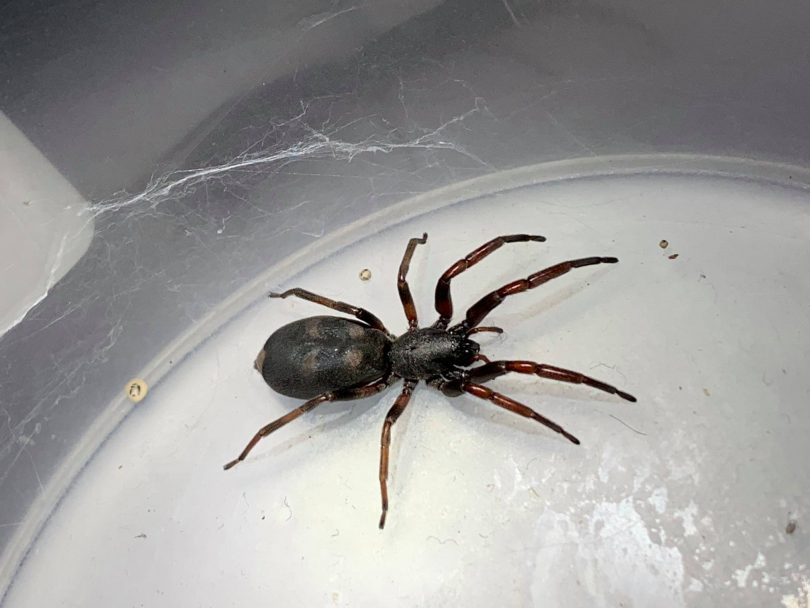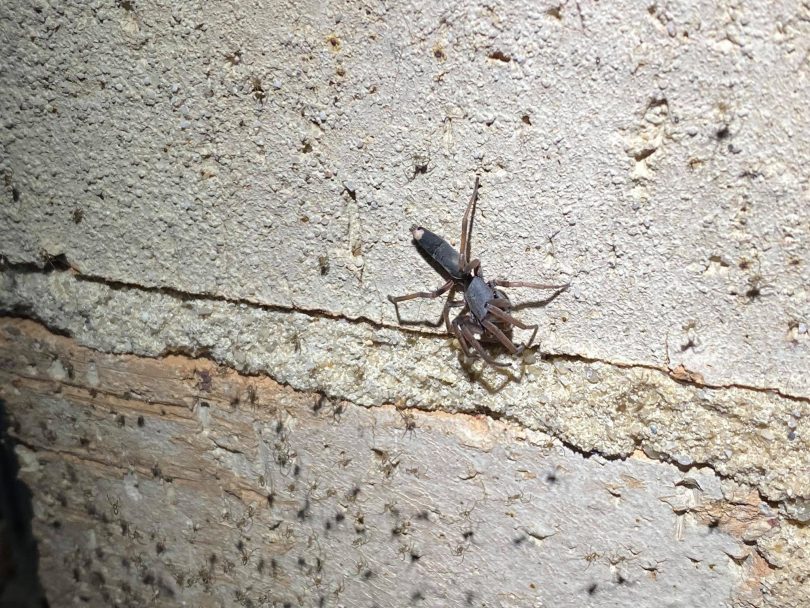
White-tails can look dangerous, but just how dangerous are they? Photo: Ben Shoard.
White-tail spiders are out in greater numbers this year after the wet weather, but experts say their dangerous reputation is worse than their bite.
It seems many of us have stories about white-tail bites – of excruciating pain, skin wounds, even loss of limbs.
But spider experts say there’s no evidence of confirmed white tail bites causing injuries anything close to that.
Goulburn-based arachnophile Benjamin Shoard, who runs the Australian Spider Identification Facebook Page, says the white-tail has been getting a bad rap.
“Everyone basically has a story about either them or a relative or a friend who had a bite or a wound from a white tail,” he says.
“A lot of the time it’s based on ‘I woke up with this sore and found a white tail a couple of hours or a few days later’, but we can’t actually put those two things together. There’s no definite link there.”
The rare condition of ‘necrotising arachnidism’, or inflammation and skin ulcers caused by spider bites, has long been incorrectly linked to white tails.
In 2003 Australian researchers Geoffrey Isbister and Michael Gray published a study of bites from spiders in the Lampona genus, of which the white tail is a part.
They found no cases of necrosis.
“There’s the odd inflamed and sore bite, but there was actually no recorded cases of infection even in the 130 confirmed cases that Isbister and Gray studied,” Ben says.
“[In 2004] they studied 11 cases that were diagnosed as white-tail bites and all of them turned out to be something different.”
Ben says confirmed bites – ones that were felt, seen and officially identified as white tails – are relatively mild.
“A little localised pain and swelling … and the odd bit of a sore similar to a mosquito bite – if you scratch it, it might break the skin and become sore and infected,” he says.
“There’s no component in the venom that causes necrosis and no confirmed bites that have become necrotic.”

Have you found any white tails in your home this season? Photo: Ben Shoard.
He’s found no record of pets being significantly harmed by white tails either.
“I actually pulled one out of the fur of my husky not long ago; he didn’t seem bothered at all,” he says.
“He was more bothered that I was trying to catch him.”
So where did the white tails get their bad reputation?
Ben’s traced the origins back to misdiagnosis in the 1980s, but hasn’t found the original publication.
“It was about 1982, there was a symposium where it was mentioned in passing as a possible problem or complication from spider bites,” he says.
“But there’s a few mixed reports of when it was and who said it.”
From there, the misconception grew.
“It wasn’t until 1987 when a doctor was trying to diagnose a patient’s necrotic wound and had heard about necrotising arachnidism,” Ben explains.
“They went and searched the house and even though they didn’t find a white tail, they decided that since white tails are common, it must have been a white-tail bite.
“From then on, that acted as a basis for further diagnoses.”
As part of his masters in biological science, Ben looked at how the actual research spreads through the general population.
“White tails were basically unheard of before around 1985,” he says.
“When you look back, all of the dangerous spiders are known – everyone knew funnel webs and redbacks.”
He found several 2017 articles about a man who had reportedly lost a leg to a white-tail bite.
“It turned out he had a mysterious infection he picked up on holiday,” Ben says.
“He was hoping it was a white-tail bite so he could get the holiday insurance to pay for it instead of his health fund.”
However, he found only a few outlets had retracted the story the next day, based on the reaction from spider experts.

The wet weather is perfect for spider breeding – look closely and you’ll see. Photo: Ben Shoard.
In 2018 Ben received a call from a man about his wife’s necrotic wound that a doctor had diagnosed as a white-tail bite and prescribed antibiotics.
“They went and got a second opinion and found out it was a staphylococcus infection and got it treated properly,” he says.
“That’s the dangerous side of it.”
The idea of white tails being incredibly dangerous to humans has become stuck in some people’s heads.
“Even though the evidence says it doesn’t happen, we’re still getting diagnoses from medical doctors,” Ben says.
“It’s understandable. They have a lot of things to read and catch up on. I’d still trust doctors more than an arachnologist to diagnose any wound.
“But I’m still probably not going to believe it if he says it’s a white-tail bite because I’d prefer to know the actual cause and get it treated.”
Ben’s not convinced the white tail will ever shake its reputation.
“It’s 20 years this year since the first publications focused on confirmed bites came out and said they’re probably not a problem,” he says.
He’s trying his best to refute the myths on social media.
“On the Australian Spider Identification Page, we’ve had to make it a rule to please not spread any unfounded information about white tails because there’s too many arguments.”
If you are bitten by a white tail, it’s recommended you apply an ice pack to relieve swelling and see a doctor if there’s any further reaction.
For information about spider bites in Australia, visit healthdirect.




















